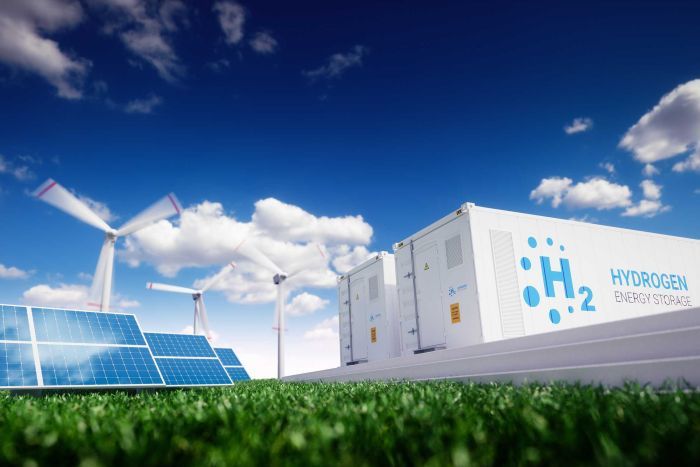The solar highway to Australia’s renewable hydrogen economy

The Australian Renewable Energy Agency says that on-site solar electrolysis is not just the most cost-effective way of developing a domestic and export hydrogen economy, but perhaps the only way.

The new Renewable Hydrogen Market Report, produced by ANT Energy Solutions and backed by the Australian Renewable Energy Agency (ARENA), features a number of key findings in the race to develop an Australian renewable hydrogen economy. The main conclusion is that on-site solar is the only way to go.
The report’s authors ran two models for renewable hydrogen produced by electrolysis, The first is a high OPEX, low CAPEX model (grid-connected, high capacity-factor), while the second is a high CAPEX, low OPEX model (behind-the-meter, low capacity-factor). The analysis indicated “that despite the much lower utilization rate, behind-the-meter solar renewable hydrogen generation can produce hydrogen at approximately half the cost per kilogram to a grid-connected system” with an electricity cost of AU$0.11 (US$0.07) per kilowatt-hour.
What this means is that the most cost-effective way of producing renewable hydrogen is by powering an electrolyzer with on-site solar. Indeed, the report suggests that hydrogen can be produced via on-site solar at a cost of $3.19 per kilogram of hydrogen versus $6.08 if produced from the grid.
Of course, considering that the costs of solar continue to decrease as efficiency rises, the cost of behind-the-meter solar hydrogen will only continue to drop, possibly below the AU$2 mark.
“Based on this alone, Australia has great potential to drive forward an increase in renewable energy and renewable hydrogen production,” the authors of the report said. “The impetus from ARENA is continuing to drive the cost of solar down with a continued reduction in the cost of large scale solar expected over the next five to 10 years.”
The call then, is for states and the federal government to support large-scale solar electrolysis as the cleanest and most obvious way to drive down the capital costs of a hydrogen economy.
Economic ecosystem
On-site solar is the most cost-effective way to build a domestic and export hydrogen industry, but it also might be the only way. “Commercialization of hydrogen as an end product requires the development of an entire economic ecosystem,” according to the report. “As with all ecosystems, they cannot function until there is critical mass in the system, so the faster scale can be developed, the more chance there is for the ecosystem to form and advantage to be generated.”
If Australia doesn’t act on its competitive advantage sooner rather than later, other countries might develop their hydrogen economies and start exporting first. The report points to Australia’s solar panel industry as an example of “where Australia failed to develop this ecosystem and competitive advantage has been lost to China and the United States, where scale of development has occurred in technology research, equipment design and fabrication.”
Businesses have already noticed the obvious competitive advantage. Toyota is installing a solar-electrolyzer at its site in Melbourne. Indeed, the company recently celebrated Earth Day by unveiling the first completed stage of its green hydrogen hub, with the help of ARENA funding.

Export potential
The CSIRO National Hydrogen Roadmap expects demand for hydrogen imports by Asian nations to reach 3.8 million tons by 2030. At the same time, ACIL Allen Opportunities for Hydrogen Exports model suggests that 10% to 20% of Japanese and South Korean hydrogen demand could be met by Australian exports. In other words, hydrogen means big business.
However, before we can talk about how much hydrogen countries such as Japan and Korea might want from us – let alone how we’ll manage to get the hydrogen up there – we must first decide how we’re going to produce said hydrogen.
In November, the COAG Energy Council adopted the National Hydrogen Strategy, our pathway to a domestic and export hydrogen economy. The strategy, however, remains “technology-neutral,” which is to say it is not solely to produce green hydrogen, but to keep Australia’s options open to fossil-fuels as well — playing the field, as it were. Although, as the ANT report shows, fossil-fuel-produced hydrogen is rather senseless compared to renewably produced hydrogen. Energy Minister Angus Taylor may think he is playing the field, but these are Flanders Fields, not Elysian ones, which is to say that Taylor is pursuing a senseless policy for the comforting sake of outdated norms.
Future forecasts
The ACIL Allen Opportunities for Hydrogen Exports model projected a mid-case forecast of 500,000 tons of hydrogen per annum by 2030. To put that in perspective, if we continue only with what we have already and what we have under construction, by 2025 we will have less than 3,000 tons per annum by 2025.
This is to say, if we don’t scale up renewable hydrogen production capacity by 160 times by 2025, we’ll be just 497,000 tons short of the ACIL Allen mid-case.

For an increase of that scale, Australia needs to put multiple industry-scale (100 MW-plus) renewable hydrogen projects in place over the next few years or the cost of production will remain too high and the hydrogen opportunity will be tentative, if not lost.
The renewable hydrogen opportunity cannot afford to be lost, as the scope of its Promethean potential is unfathomable, but there is much that can be understood already. If renewable hydrogen breaks the $2 per kilogram barrier, for example, it could immediately replace the domestic market for natural gas feedstock and provide a low-cast pathway to a green ammonia export industry, let alone Australia’s grander export ambitions. But, of course, “industry-scale renewable hydrogen development will require government and industry support to enable the adoption and the continued reduction in the cost per kilogram of renewable hydrogen … At levels below A$1.95 between 2025 and 2030, Australia will be able to transition a domestic market and be competitive in the forecast export markets.”
Currently, it is estimated that only 2% to 4% of the world’s hydrogen is produced via electrolysis.
From: https://www.pv-magazine.com/2020/04/28/the-solar-highway-to-australias-renewable-hydrogen-economy/

